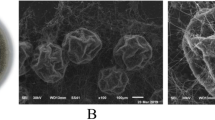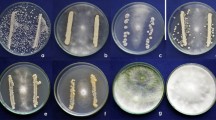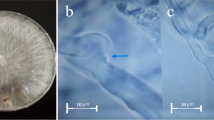Abstract
The efficacy of eight fungal and eight bacterial isolates was tested for their ability to inhibit the growth of Sclerotium rolfsii, the causal agent of collar rot of peppermint. In vitro studies revealed that Trichoderma harzianum (THA) and Pseudomonas fluorescens (PFM) showed the highest inhibition of mycelial growth (68.28; 74.25 %) of S. rolfsii. The antagonists T. harzianum and P. fluorescens were compatible with each other and they were tested alone and together in in vivo for the control of S. rolfsii. Besides, the induction of defense-related enzymes such as peroxidase, polyphenoloxidase, phenylalanine ammonia-lyase, and the accumulation of phenolics in peppermint plants due to the application of bioagents were also studied. Combined application of talc-based formulation of bioagents and challenge inoculation with S. rolfsii recorded maximum induction of defense-related enzymes, and accumulation of phenolics as compared with individual application. This study suggests that the increased induction of defense-related enzymes (two- to threefold) and phenolic content (threefold) due to the combination treatment of bioagents might be involved in the reduction of collar rot incidence.
Similar content being viewed by others
Abbreviations
- THA:
-
Trichoderma harzianum Attupalam
- PFM:
-
Pseudomonas fluorescens Morepalayam
- PR:
-
Pathogenesis-related protein
- PO:
-
Peroxidase
- PPO:
-
Polyphenoloxidase
- PAL:
-
Phenylalanine ammonia-lyase
- PGPR:
-
Plant growth promoting rhizobacteria
- ISR:
-
Induced systemic resistance
References
Ainsworth GC (1961) Dictionary of the fungi. Can J Microbiol 34:157–161
Alstrom S (1991) Induction of disease resistance in common bean susceptible to halo blight bacterial pathogen after seed bacterization with rhizosphere pseudomonads. J Gen Appl Microbiol 37:495–501
Anand S, Bahadur Harikesh (2004) Control of collar rot in mint (Mentha spp.) caused by Sclerotium rolfsii using biological means. Curr Sci 87:362–366
Anonymous (2004) Essential oils association of India. http://www.nhb.gov.in/Horticulture
Bell JN, Dixon RA, Bailey JA, Rowell PM, Lamb CJ (1984) Differential induction of chalcone synthase mRNA activity at the onset of phytoalexin accumulation in compatible and in compatible plant–pathogen interactions. Pro Natl Acad Sci USA 81:3384–3388
Bharathi R, Vivekanandhan R, Harish S, Ramanathan A, Samiyappan R (2004) Rhizobacteria-based bio-formulations for the management of fruit rot infection in chillies. Crop Prot 23:835–843
Bhuiyan MA, Rahman HB, Bhuiyan KA (2012) In vitro screening of fungicides and antagonists against Sclerotium rolfsii. Afr J Biotechnol 11:14822–14827
Chen C, Belanger RR, Benhamou N, Paulitz TC (2000) Defense enzymes induced in cucumber roots by treatment with plant growth promoting rhizobacteria (PGPR). Physiol Mol Plant Pathol 56:13–23
Dennis L, Webster J (1971) Antagonistic properties of species group of Trichoderma I. Production of non-volatile antibiotics. Trans Br Mycol Soc 57:25–39
Dickerson DP, Pascholari SF, Hagerman AE, Butler LG, Niholson RL (1984) Phenylalanine ammonia lyase and hydroxyl cinnamate: Co A ligase in maize mesocotyls inoculated with Helminthosporium maydis or Hemlinthosporium carbonum. Physiol Mol Plant Pathol 25:111–123
Duffy BK, Simon A, Weller DM (1996) Combination of Trichoderma koningii with fluorescent pseudomonads for control of take-all on wheat. Phytopathology 86:188–194
Elad Y, Chet I (1983) Improved selective media for isolation of Trichoderma or Fusarium spp. Phytoparasitica 11:55–58
Eziashi EI, Omamor IB, Odigie EE (2007) Antagonism of Trichoderma viride and effects of extracted water soluble compounds from Trichoderma species and benlate solution on Ceratocystis paradoxa. Afr J Biotechnol 6:388–392
Fukui R, Schroth MN, Hendson M, Hancock JG (1994) Interaction between strains of pseudomonads in sugar beet spermospheres and the relationship to pericarp colonization by Pythium ultimum in soil. Phytopathology 84:1322–1330
Ganesan S (2004) Studies on the biocontrol of soil-borne plant pathogens. Ph.D. Thesis, Madurai Kamarajar University, Madurai
Ganesan S, Sekar R (2004) Biocontrol mechanism of groundnut (Arachis hypogea L.) diseases-Trichoderma systems. Biotechnological Applications in Environment and Agriculture, Jaipur, pp 312–327
Ganesan SP, Manimaran K, Ramesh, Sekar R (2003) Biocontrol of onion basal rot disease caused by Fusarium oxysporum f.sp.cepae. Microbiol Society, Maharastra, pp 119–124
Ghildiyal A, Pandey A (2008) Isolation of cold tolerant antifungal strains of Trichoderma species from glacial sites of Indian Himalayan region. Res J Microbiol 8:559–564
Gomez KA, Gomez AA (1984) Statistical procedure for agricultural research. Wiley, New York
Gross GG (1980) The biochemistry of lignification. Adv Bot Res 8:25–63
Gupta CP, Dubey RC, Kang SC, Maheshwari DK (2001) Antibiosis mediated necrotrophic effect of Pseudomonas GRC2 against two fungal plant pathogens. Curr Sci 81:91–94
Hammerschmidt R, Nuckles EM, Kuc J (1982) Association of enhanced peroxidase activity with induced systemic resistance of cucumber to Colletotrichum lagenarium. Physiol Plant Pathol 20:73–82
Ingham JL (1972) Phytoalexins and other natural products as factors in plant diseases. Bot Rev 38:343–424
Kamalakannan A, Mohan L, Kavitha K, Harish S, Radjacommare R, Nakkeeran S, Parthiban VK, Karuppiah R, Angayarkanni T (2003) Enhancing resistance to stem and stolen rot of peppermint (Mentha pipertia Linn.) using bio-control agents. Acta Phytopathol Entomol Hung 38:293–305
Kavitha K, Mathiyazhahan S, Sendhilvel V, Nakkeeran S, Chandrasekar G (2005) Development of bio formulations of antagonistic bacteria for the management of damping-off in chilli. Arch Phytopathol Plant Prot 38:19–30
King EO, Ward MK, Raney DE (1954) Two simple media for the demonstration of pyocyanine and fluorescein. J Lab Clin Med 44:301–307
Leahy JG, Colwell RR (1990) Microbial degradation of hydrocarbons in the environment. Microbiol Rev 54:305–315
Leeman M, Van Pelt JA, Den Ouwden FM, Heinsbroek M, Bakker PAHM, Schippers B (1995) Induction of systemic resistance against Fusarium wilt of radish by lipopolysaccharides of Pseudomonas fluorescens. Phytopathology 85:1021–1027
Li DM, Alexander M (1998) Co-inoculation with antibiotic-producing bacteria to increase colonization and nodulation by rhizobia. Plant Soil 108:211–219
Liang JG, Zhang BX, Chen ZY, Yu JQ (2006) Studies on the resistance to cucumber damping- off induced by plant growth promoting rhizobacteria CH1. Acta Hortic Sin 33:282–288
Liu L, Kloepper JW, Tuzun S (1995) Induction of systemic resistance in cucumber against bacterial angular leaf spot by plant growth promoting rhizobacteria. Phytopathology 85:843–847
Maurhofer M, Hase C, Meuwly P, Metraux JP, Defago G (1994) Induction of systemic resistance of tobacco to tobacco necrosis virus by the root-colonizing Pseudomonas fluorescens strain CHAO: influence of the gcaA gene and pyoverdine production. Phytopathology 84:139–146
Mayer AM, Harel E, Shaul RB (1965) Assay of catechol oxidase a critical comparison of methods. Phytochemistry 5:783–789
Meena B, Radhajeyalakshmi R, Marimuthu T, Vidhyasekaran P, Sabitha D, Velazhahan R (1999) Induction of pathogenesis related proteins, phenolics and phenylalanine ammonia-lyase in groundnut by Pseudomonas fluorescens. J Plant Dis Prot 107:524–527
Mortensen CN (1992) Seed bacteriology laboratory guide. Danish Government Institute of Seed Pathology for Developing Countries, Copenhagen
Muthukumar A, Nakkeeran S, Eswaran A, Sangeetha G (2010) In vitro efficacy of bacterial endophytes against the chilli damping-off pathogen Pythium aphanidermatum. Phytopathol Mediterr 49:179–186
Muthukumar A, Eswaran A, Sangeetha G (2011) Induction of systemic resistance by mixtures of fungal and endophytic bacterial isolates against Pythium aphanidermatum. Acta Physiol Plant 33:1933–1944
Nakkeeran S, Kavitha K, Chandrasekar G, Renukadevi P, Fernando WGD (2006) Induction of plant defence compounds by Pseudomonas chlororaphis PA 23 and Bacillus subtilis BSCBE 4 in controlling damping-off of hot pepper caused by Pythium aphanidermatum. Biocontrol Sci Technol 16:403–416
Nandakumar R, Babu S, Viswanathan R, Sheela J, Raguchander T, Samiyappan R (2001) A new bio-formulation containing plant growth promoting rhizobacterial mixture for the management of sheath blight and enhanced grain yield in rice. Biol Control 46:493–510
Nielson MN, Sorensen J, Fels J, Pedersen HC (1998) Secondary metabolite and endo chitinase dependent antagonism towards plant pathogenic micro fungi of Pseudomonas fluorescens isolates from sugar beet rhizosphere. Appl Environ Microbiol 64:563–3569
Niranjana SR, Lalitha S, Hariprasad P (2009) Mass multiplication and formulations of biocontrol agents for use against Fusarium wilt of Pigeonpea through seed treatment. Int J Pest Manag 55:317–324
Papavizas GC, Dunn MT, Lewis JA, Beagle-Ristaino J (1984) Liquid fermentation technology for experimental production of biocontrol fungi. Phytopathology 74:1171–1175
Paramageetham CH (2013) Bio control of Sclerotium rolfsii a polyphagous plant pathogen by Pseudomonas aeruginosa isolated from forest liter. Int J Res Plant Sci 3:1–4
Pastor NA, Reynoso MM, Tonelli ML, Masciarelli O, Rosaso SB, Tonelli ML, Masciarelli D, Rosas SB, Rovera M (2010) Potential bio control Pseudomonas sp. Pc12 against damping-off of tomato caused by Sclerotium rolfsii. J Plant Pathol 92:737–745
Punja ZK, Damini A (1996) Comparative growth, morphology and physiology of three Sclerotium species. Mycologia 88:694–706
Radwan M, Baraka Fadel AL, Mahareeq I, Mohammad IAL (2006) Biological control of Sclerotium rolfsii by using indigenous Trichoderma spp. isolates from Palestine. Hebron Univ Res J 2:27–47
Rajendran L, Samiyappan R (2008) Endophytic Bacillus species confer increased resistance in cotton against damping-off disease caused by Rhizoctonia solani. Plant Pathol 7:1–12
Ramamoorthy V, Raguchander T, Samiyappan R (2002) Enhancing resistance of tomato and hot pepper to Pythium disease by seed treatment with fluorescent pseudomonads. Eur J Plant Pathol 108:429–441
Rangeshwaran R, Raj J, Sreeramakumar P (2008) Identification of endophytic bacteria in chickpea (Cicer arietinum L.) and their effect on plant growth. J Biol Control 22:13–23
Samuels GJ, Chaverri P, Farr DF, McCray EB (2004) USDA, Beltsville, USA. Trichoderma online systematic Botany and Mycology Laboratory, ARS, USDA. Retrieved September 20, 2004, from http://nt.arsgrin.gov/taxadescriptions/keys/TrichodermaIndex.cfm
Sangeetha G, Thangavelu R, Usha Rani S, Muthukumar A, Udayakumar R (2010) Induction of systemic resistance by mixtures of antagonist bacteria for the management of crown rot complex on banana. Acta Physiol Plant 32:1177–1187
Saravanakumar D, Vijayakumar C, Kumar N, Samiyappan R (2007) PGPR-induced defense responses in the tea plant against blister blight disease. Crop Prot 26:556–565
Sarma BK, Singh UP, Singh KP (2002) Variability in Indian isolates of Sclerotium rolfsii. Mycologia 94:1051–1058
Shukla PK, Haseeb AS, Sharma S (1998) Soil texture, root lesion nematodes and yield of peppermint (Mentha piperita). J Herbs Spices Med Plants 6:1–8
Van Peer R, Schippers B (1992) Lipopolysaccharides of plant growth promoting Pseudomonas spp. strain WCS417r induce resistance in carnation to Fusarium wilt. Neth J Plant Pathol 98:129–139
Van Peer R, Niemann GJ, Schippers B (1991) Induced resistance and phytoalexin accumulation in biological control of Fusarium wilt of carnation by Pseudomonas sp. Strain WCA417r. Phytopathology 81:728–734
Velazhahan R, Vidhyasekaran P (1994) Role of phenolic compounds, peroxidase and polyphenol-oxidase in resistance of groundnut to rust. Acta Phytopathol Entomol Hung 29:23–29
Vidhyasekaran P, Muthamilan M (1995) Development of formulations of Pseudomonas fluorescens for control of chickpea wilt. Plant Dis 79:782–786
Vincent JM (1929) Distribution of fungal hyphae in the presence of certain inhibitors. Nature 159:850
Vinothkumar A, Kumar VC, Verma SK, Kharwar RN (2007) Induction of defense enzymes in Pseudomonas fluorescens treated chickpea roots against Macrophomina phaseolina. Indian Phytopathol 60:289–295
Viswanathan R, Samiyappan R (1999) Induction of systemic resistance by plant growth promoting rhizobacteria against red rot disease caused by Colletotrichum falcatum in sugarcane. Proc Sugar Technol Assoc 61:24–39
Vivekanandhan R, Ravi M, Sible GV, Prakasam V, Samiyappan R (2004) Pseudomonas fluorescens (FP7) amended with chitin bioformulation for the management of anthracnose pathogen in mango cultivar Alphonso. Madras Agric J 91:475–782
Watanabe T (2002) Sclerotium sp. morphologies of cultured fungi and key species: pictorial atlas of soil and seed fungi, 2nd edn. CRC Press, New York
Wei G, Kloepper JW, Tuzun S (1991) Induction of systemic resistance of cucumber to Colletotrichum orbiculare by selected strains of plant growth-promoting rhizobacteria. Phytopathology 41:1508–1512
Xue L, Charest PM, Jabaji-Hare SH (1998) Systemic induction of peroxidases, β-1, 3-glucanases, chitinases and resistance in bean plants by binucleate Rhizoctonia species. Phytopathology 88:359–365
Yedidia I, Benhamou N, Chet I (1999) Concomitant induction of systemic resistance to Pseudomonas syringea pv. lachrymans in cucumber by Trichoderma asperellum and accumulation of phytoalexins. Appl Environ Microbiol 69:7343–7353
Zhuang J, Gao Z, Yang C, Chen J, Xue Y, Lianxiao M (2005) Biocontrol of Fusarium wilt and induction of defense enzyme activities on cucumber by Trichoderma viride strain T23. Acta Phytopathol Sin 35:179–183
Zieslin N, Ben-Zaken R (1993) Peroxidase activity and presence of phenolic substances in peduncles of rose flowers. Plant Physiol Biochem 31:333–339
Author information
Authors and Affiliations
Corresponding author
Additional information
Communicated by A. Krolicka.
Rights and permissions
About this article
Cite this article
Muthukumar, A., Venkatesh, A. Biological inductions of systemic resistance to collar rot of peppermint caused by Sclerotium rolfsii . Acta Physiol Plant 36, 1421–1431 (2014). https://doi.org/10.1007/s11738-014-1520-1
Received:
Revised:
Accepted:
Published:
Issue Date:
DOI: https://doi.org/10.1007/s11738-014-1520-1




